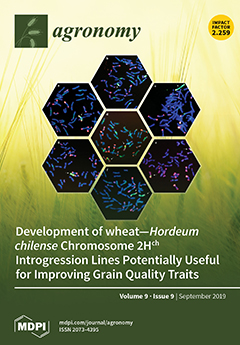Ver ítem
- xmlui.general.dspace_homeCentros e Institutos de InvestigaciónCICVyA. Centro de Investigación en Ciencias Veterinarias y AgronómicasInstituto de BiotecnologíaArtículos científicosxmlui.ArtifactBrowser.ItemViewer.trail
- Inicio
- Centros e Institutos de Investigación
- CICVyA. Centro de Investigación en Ciencias Veterinarias y Agronómicas
- Instituto de Biotecnología
- Artículos científicos
- Ver ítem
Optimizing ddRADseq in non-model species: a case study in Eucalyptus dunnii maiden
Resumen
Restriction site-associated DNA sequencing (RADseq) and its derived protocols, such as double digest RADseq (ddRADseq), offer a flexible and highly cost-effective strategy for efficient plant genome sampling. This has become one of the most popular genotyping approaches for breeding, conservation, and evolution studies in model and non-model plant species. However, universal protocols do not always adapt well to non-model species. Herein, this study
[ver mas...]
Restriction site-associated DNA sequencing (RADseq) and its derived protocols, such as double digest RADseq (ddRADseq), offer a flexible and highly cost-effective strategy for efficient plant genome sampling. This has become one of the most popular genotyping approaches for breeding, conservation, and evolution studies in model and non-model plant species. However, universal protocols do not always adapt well to non-model species. Herein, this study reports the development of an optimized and detailed ddRADseq protocol in Eucalyptus dunnii, a non-model species, which combines different aspects of published methodologies. The initial protocol was established using only two samples by selecting the best combination of enzymes and through optimal size selection and simplifying lab procedures. Both single nucleotide polymorphisms (SNPs) and simple sequence repeats (SSRs) were determined with high accuracy after applying stringent bioinformatics settings and quality filters, with and without a reference genome. To scale it up to 24 samples, we added barcoded adapters. We also applied automatic size selection, and therefore obtained an optimal number of loci, the expected SNP locus density, and genome-wide distribution. Reliability and cross-sequencing platform compatibility were verified through dissimilarity coefficients of 0.05 between replicates. To our knowledge, this optimized ddRADseq protocol will allow users to go from the DNA sample to genotyping data in a highly accessible and reproducible way.
[Cerrar]

Autor
Aguirre, Natalia Cristina;
Filippi, Carla Valeria;
Zaina, Giusi;
Rivas, Juan Gabriel;
Acuña, Cintia Vanesa;
Villalba, Pamela Victoria;
Garcia, Martin Nahuel;
Gonzalez, Sergio;
Rivarola, Maximo Lisandro;
Martinez, Maria Carolina;
Puebla, Andrea Fabiana;
Morgante, Michele;
Hopp, Horacio Esteban;
Paniego, Norma Beatriz;
Marcucci Poltri, Susana Noemi;
Fuente
Agronomy 9 (9) : 484 (Agosto 2019)
Fecha
2019-08
Editorial
MDPI
ISSN
2073-4395
Documentos Relacionados
Formato
pdf
Tipo de documento
artículo
Proyectos
(ver más)
INTA/PNBIO/1131042/AR./Genómica aplicada al mejoramiento molecular.
Palabras Claves
Derechos de acceso
Abierto
 Excepto donde se diga explicitamente, este item se publica bajo la siguiente descripción: Creative Commons Attribution-NonCommercial-ShareAlike 2.5 Unported (CC BY-NC-SA 2.5)
Excepto donde se diga explicitamente, este item se publica bajo la siguiente descripción: Creative Commons Attribution-NonCommercial-ShareAlike 2.5 Unported (CC BY-NC-SA 2.5)


